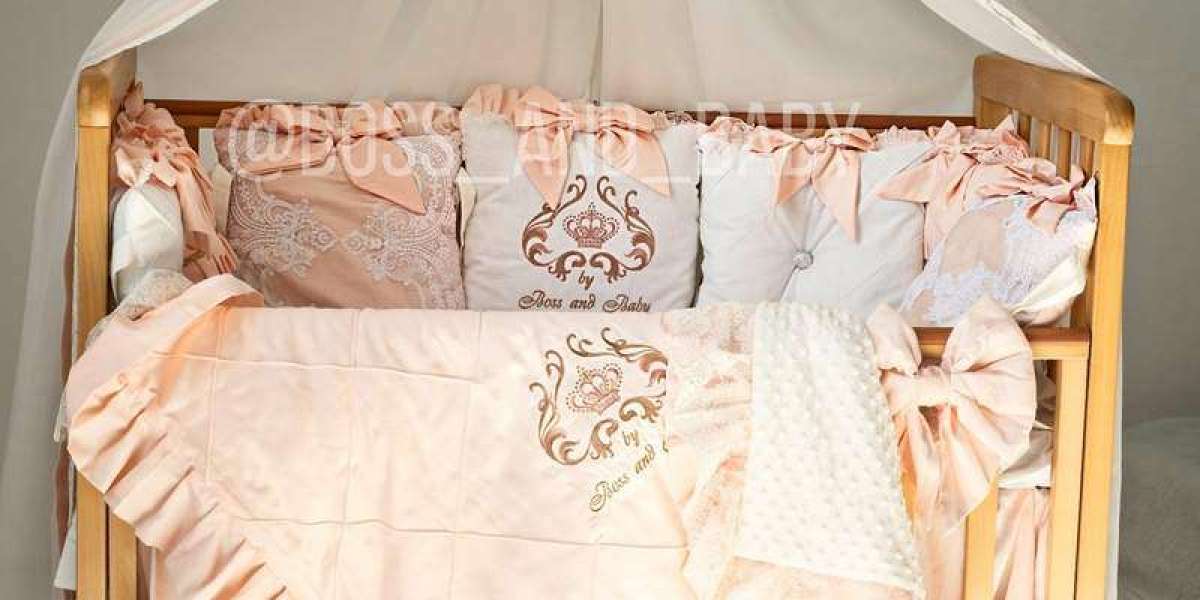In the heart of modern nursery design lies a movement toward tranquility, timelessness, and understated elegance. Parents today are increasingly drawn to creating calm, soothing sanctuaries for their little ones, and the cornerstone of this aesthetic is often the neutral crib bedding set. Moving beyond fleeting trends and traditional color norms, a neutral palette offers a sophisticated canvas that is both versatile and profoundly peaceful.
But a neutral nursery is far from boring. It is an intentional choice that embraces the beauty of texture, the subtlety of pattern, and the serenity of a cohesive space. This definitive guide will explore the art and science behind creating the perfect neutral nursery. We will delve into the powerful benefits of a neutral color scheme, establish the non-negotiable rules of infant safety that underpin all design choices, and show you how to layer tones and textures to create a room that is as interesting as it is calming.
Chapter 1: Why Choose Neutral? The Enduring Appeal of a Calm Palette
Opting for a neutral theme is more than just a stylistic preference; it’s a practical and thoughtful decision with a multitude of benefits for both baby and parents.
A Sanctuary of Serenity: A baby's developing senses can easily become overstimulated. A nursery decorated in soft, muted tones—such as warm whites, gentle grays, earthy beiges, and soft greens—creates a calming environment that can promote better sleep and reduce fussiness. This tranquil atmosphere is also a welcome retreat for parents during late-night feedings and quiet moments.
The Ultimate in Versatility: A neutral foundation is timeless. It grows with your child, effortlessly adapting from an infant's nursery to a toddler's room and beyond. As your child develops their own personality and preferences, you can easily introduce new accent colors through accessories, toys, and artwork without needing to overhaul the core decor.
Timeless, Gender-Inclusive Style: Neutral nurseries gracefully sidestep traditional gender stereotypes, offering a sophisticated and modern alternative. This approach is perfect for parents who are waiting to find out the gender of their baby, or for those who simply prefer a more inclusive and contemporary aesthetic. High-quality neutral bedding can also be passed down to future siblings, making it a sustainable choice.
A Canvas for Personality: A neutral backdrop makes other elements in the room pop. A beautifully crafted wooden crib, a vibrant piece of wall art, a textured rug, or a collection of colourful books become focal points. The neutral bedding doesn't compete for attention; it enhances the beauty of the carefully chosen items around it.
Chapter 2: The Foundation of Safety in a Neutral Nursery
No matter the color palette, the rules of safe infant sleep are universal and non-negotiable. A beautiful nursery must, above all else, be a safe nursery. The American Academy of Pediatrics (AAP) provides clear guidelines to minimize the risk of SIDS (Sudden Infant Death Syndrome).
Safety is Non-Negotiable, Regardless of Color
The "Bare is Best" principle is the golden rule:
A Firm Mattress & Fitted Sheet Only: The only items inside the crib should be a firm, flat mattress that fits the crib frame perfectly and a snug-fitting fitted sheet.
A Completely Empty Crib: The crib must be free of all soft items. This includes quilts, comforters, blankets, pillows, and padded crib bumpers (which are a known safety hazard and now banned in many places).
Back to Sleep: Always place your baby on their back for every sleep.
Use a Wearable Blanket: To keep your baby warm, use a sleep sack or wearable blanket—the only safe alternative to a loose blanket.
When you purchase a neutral crib bedding "set," understand that most pieces are for decorating the room, not the crib. The fitted sheet is the star player for the crib itself. The matching quilt can be used as a wall hanging, and the crib skirt is a safe way to add a finishing touch.
Chapter 3: The Nuances of Neutral: Beyond Beige and White
The world of neutrals is rich and varied. Creating a sophisticated look involves layering different shades and tones.
Warm Neutrals: These colours have undertones of red, yellow, or orange. Think ivory, cream, beige, taupe, and soft, muted terracotta. They create a cozy, inviting, and sun-kissed atmosphere.
Cool Neutrals: With undertones of blue, green, or purple, these colours create a crisp, serene, and modern feel. This family includes bright white, soft light gray, and "greige" (a popular blend of gray and beige).
Earthy Neutrals: Inspired by nature, this palette includes colors like sage green, moss, mushroom, and clay. These tones are grounding, peaceful, and connect the nursery to the natural world.
Pro Tip: For a designer look, choose two or three neutrals from the same family (e.g., ivory, beige, and a darker taupe) and layer them throughout the room for a rich, tonal effect.
Chapter 4: Bringing a Neutral Nursery to Life with Texture and Pattern
The secret to ensuring a neutral nursery feels sophisticated and not sterile is to introduce a rich variety of textures and subtle patterns.
Texture Creates Depth and Interest When your color palette is restrained, texture does the heavy lifting. Look for fitted sheets and other nursery textiles (used safely outside the crib) with tangible, interesting surfaces:
Waffle Weave: Adds a classic, grid-like texture that feels cozy and substantial.
Linen and Slub Cotton: These fabrics have natural, subtle variations in their thread, giving them a beautiful organic and slightly rustic texture.
Ribbed or Pointelle Knits: A soft, stretchy ribbed knit sheet adds linear texture and a modern feel.
Matelassé: This stitching technique creates a raised, quilted-like pattern on a single layer of fabric, offering elegance and dimension.
Subtle Patterns Add Personality Pattern in a neutral nursery should whisper, not shout. Look for simple, timeless designs on the fitted sheet:
Delicate Stripes or Pinstripes
Simple Grids or Windowpane Checks
Minimalist Dots or Plus Signs
Subtle Botanical or Animal Line Drawings in a tonal color.
By layering a ribbed knit fitted sheet with a simple crib skirt and placing a chunky knit blanket on a nearby chair, you create a dynamic, multi-dimensional space that is a delight to the senses.
Chapter 5: The Practical Side of Neutral Bedding
Fabric Choices: The neutral aesthetic pairs perfectly with high-quality, natural fabrics. Organic cotton, linen, and bamboo are all excellent choices that are soft, breathable, and safe for a baby's sensitive skin.
Care and Maintenance: While lighter colors can seem intimidating, modern, baby-safe stain removers are very effective. Having multiple fitted sheets (4-6 is a good number) on hand ensures you're always prepared. Washing in warm water with a gentle detergent will keep your bedding fresh and clean.
Mattress Protection: A waterproof, breathable mattress protector is essential under any fitted sheet to protect the mattress from inevitable leaks and spills.
Conclusion
Choosing a neutral crib bedding set is an investment in a timeless, serene, and incredibly versatile nursery. It is a style that exudes a quiet confidence and provides the perfect, peaceful backdrop for the beautiful chaos of new parenthood. By embracing the rich world of neutral tones and focusing on layering textures and subtle patterns—all within the vital framework of safe sleep—you can effortlessly create a sophisticated and loving sanctuary for your baby.
Frequently Asked Questions (FAQs)
1. Will a neutral nursery be boring or under-stimulating for my baby? Not at all. While the overall room is calm, a baby's immediate environment in the crib can include a high-contrast fitted sheet (like black and white patterns) for visual development. The wider room can have stimulating toys and books for playtime, which can be easily stored away for sleep.
2. How do I keep white or cream-colored bedding clean? Have multiple sheets on hand for quick changes. Treat stains immediately with a baby-safe stain remover before laundering. Washing in warm water and occasionally sun-drying can also help maintain brightness.
3. What are the best accent colors for a neutral nursery? The beauty of neutral is that almost any color works! Soft options include muted blues, blush pink, or lilac. For a bolder look, consider accents of mustard yellow, deep teal, or even black.
4. Is a neutral nursery suitable for both baby boys and girls? Absolutely. This is one of its primary strengths. Neutral themes are inherently gender-inclusive, creating a stylish space for any child.
5. How can I add personality to a neutral nursery? Through personal touches! Add family photos, a custom name sign, a special mobile (hung safely out of reach), or a colourful rug. The neutral bedding provides the perfect canvas for these items to stand out.
6. Are linen sheets a good choice for a baby? Yes, linen is an excellent choice. It's natural, highly breathable, moisture-wicking, and becomes softer with every wash.
7. Can I mix different neutral shades, like gray and beige? Yes! Mixing warm and cool neutrals (like gray and beige, often called "greige") is a sophisticated design choice that creates a layered, interesting look.
8. Is a patterned fitted sheet okay in a neutral nursery? Definitely. A subtle, tonal pattern on the fitted sheet is a great way to add visual interest without disrupting the overall serene feel.
9. How many bedding sets do I need? You don't need multiple "sets." Instead, invest in 4-6 high-quality fitted sheets and one or two crib skirts. The decorative quilt is an optional, one-time purchase for room decor.
10. What is the most important safety rule for any crib bedding? The crib must be bare. Only a firm mattress and a tight-fitting fitted sheet should be inside the crib with the baby.
11. Are textured sheets safe for a baby's skin? Yes, as long as the texture comes from the weave of a soft, natural fabric (like waffle or ribbed cotton). Avoid anything with harsh, synthetic, or abrasive elements.
12. How do I make a neutral nursery feel warm and cozy? Layer textures. Use soft rugs, chunky knit blankets (on chairs, not in the crib), soft lighting, and warm wood tones in the furniture to create a cozy, inviting atmosphere.
13. Does the crib skirt have to match the fitted sheet exactly? No, a coordinated look is often more stylish than a perfectly matched one. A simple, solid-colored crib skirt often works best with a patterned fitted sheet, and vice versa.
14. What are the best neutral paint colors for a nursery? Look for soft, warm whites (like Benjamin Moore's "White Dove"), versatile greiges (like Sherwin-Williams' "Agreeable Gray"), or gentle sage greens.
15. Can I use a decorative pillow from the set for nursing? It's better to use a pillow designed specifically for nursing support. The small decorative pillows in bedding sets usually don't offer the right size or firmness for ergonomic feeding.



